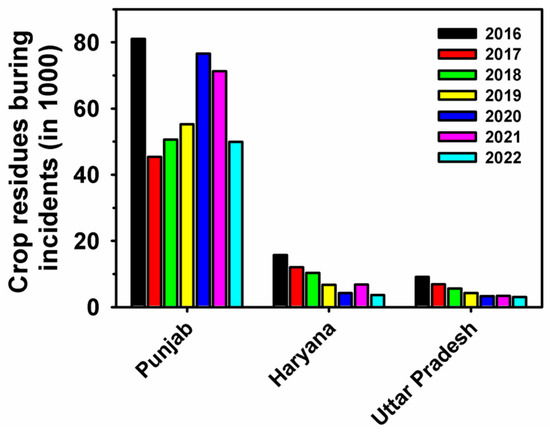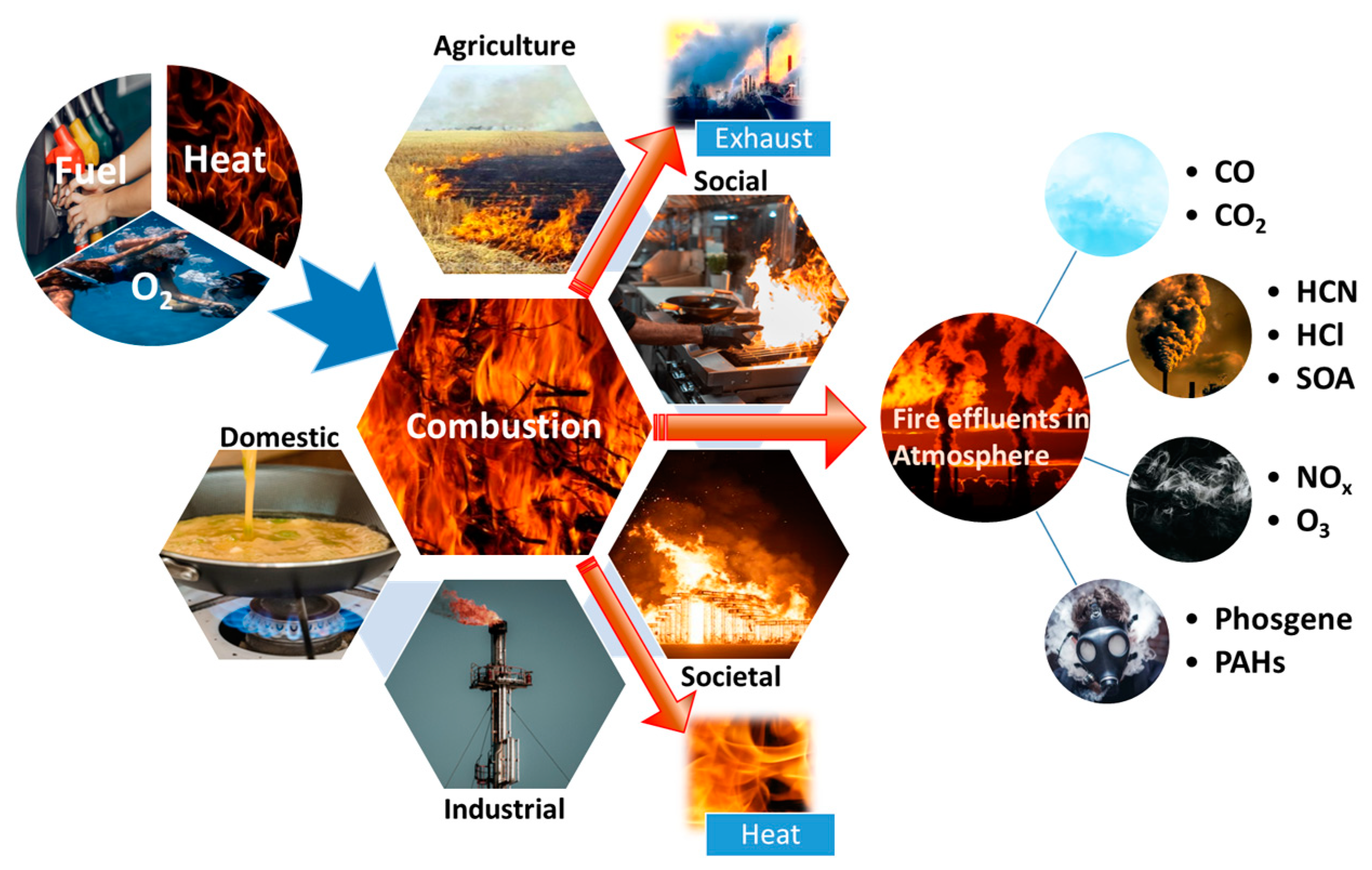Combustion is an essential process for humanity, but it has created turbulence in society due to the pollutant emissions from the partial completion of its process and its byproducts. According to the system of air quality and weather forecasting and research (SAFAR), stubble burning’s contribution to air pollution (as PM) was 25% in 2021, 32% in 2020, and 19% in 2019, while the fire count between September and November was 71,304 in 2021, and 83,002 in 2020, respectively. This has been known to directly affect Delhi’s AQI. Combustion effluents are generated in response to the behavior of the burning process and product toxicity, which further resides in the fire plot (orientation and fuel’s shape), material composition, oxygen concentration, and temperature.
- combustion
- fuel
- emission
1. Introduction
2. Combustion and Stubble Burning Effluent Emissions



2.1. Combustion and Stubble Burning Contribution
2.2. Dispersal of the Combustion and Stubble Burning Effluents
This entry is adapted from the peer-reviewed paper 10.3390/fire6020079
References
- Patel, S.K.S.; Das, D.; Kim, S.C.; Cho, B.-K.; Lee, J.-K.; Kalia, V.C. Integrating strategies for sustainable conversion of waste biomass into dark-fermentative hydrogen and value-added products. Renew. Sustain. Energy Rev. 2021, 150, 111491.
- Ritchie, H.; Roser, M.; Rosado, P. Research and Data to Make Progress against the World’s Largest Problems. 2022. Available online: OurWorldInData.org (accessed on 25 January 2023).
- Lewtas, J. Air pollution combustion emissions: Characterization of causative agents and mechanisms associated with cancer, reproductive, and cardiovascular effects. Mutat. Res. Rev. Mutat. Res. 2007, 636, 95–133.
- Abdurrahman, M.I.; Chaki, S.; Saini, G. Stubble burning: Effects on health & environment, regulations and management practices. Environ. Adv. 2020, 2, 100011.
- Yadav, R.S. Stubble Burning: A Problem for the Environment, Agriculture, and Humans. Down to Earth. 4 June 2019. Available online: https://www.downtoearth.org.in/blog/agriculture/stubble-burning-a-problem-for-the-environment-agriculture-and-humans-64912 (accessed on 25 January 2023).
- Stubble Burning is So Bad in Punjab, That 84% Population is Having Health Issues. Available online: https://www.indiatimes.com/news/india/stubble-burning-is-so-bad-in-punjab-that-84-of-population-is-having-health-issues-331980.html (accessed on 25 January 2023).
- Vishnoi, A. Magnitude of Stubble Problem Grows Larger: Govt Review. Available online: https://economictimes.indiatimes.com/news/india/magnitude-of-stubble-problem-grows-larger-govt-review/articleshow/94571984.cms?from=mdr (accessed on 25 January 2023).
- Omar, P. Stubble Burning Share Rises to 26% in Delhi’s Pollution, AQI Points ‘Severe’. Available online: https://www.livemint.com/news/india/stubble-burning-share-rises-to-26-in-delhi-s-pollution-aqi-points-severe-11667131222272.html (accessed on 25 January 2023).
- Patel, S.K.S.; Shanmugam, R.; Lee, J.-K.; Kalia, V.C.; Kim, I.-W. Biomolecules production from greenhouse gases by methanotrophs. Indian J. Microbiol. 2021, 61, 449–457.
- Patel, S.K.S.; Gupta, R.K.; Kalia, V.C.; Lee, J.-K. Synthetic design of methanotroph co-cultures and their immobilization within polymers containing magnetic nanoparticles to enhance methanol production from wheat straw-based biogas. Bioresour. Technol. 2022, 364, 128032.
- Patel, S.K.S.; Kalia, V.C.; Lee, J.-K. Integration of biogas derived from dark fermentation and anaerobic digestion of biowaste to enhance methanol production by methanotrophs. Bioresour. Technol. 2023, 367, 128427.
- Loomis, D.; Grosse, Y.; Lauby-Secretan, B.; El Ghissassi, F.; Bouvard, V.; Benbrahim-Tallaa, L.; Guha, N.; Baan, R.; Mattock, H.; Straif, K.; et al. The carcinogenicity of outdoor air pollution. Lancet Oncol. 2013, 14, 1262–1263.
- Kravchenko, J.; Ruhl, L.S. Coal Combustion Residuals and Health. In Practical Applications of Medical Geology; Siegel, M., Selinus, O., Finkelman, R., Eds.; Springer: Cham, Switzerland, 2021; pp. 429–474.
- Corsini, E.; Marinovich, M.; Vecchi, R. Ultrafine particles from residential biomass combustion: A review on experimental data and toxicological response. Int. J. Mol. Sci. 2019, 20, 4992.
- Balmes, J.R. Household air pollution from domestic combustion of solid fuels and health. J. Allergy Clin. Immunol. Pract. 2019, 143, 1979–1987.
- Keeley, J.E. Fire intensity, fire severity and burn severity: A brief review and suggested usage. Int. J. Wildland Fire 2009, 18, 116–126.
- Belcher, C.M. The influence of leaf morphology on litter flammability and its utility for interpreting palaeofire. Phil. Trans. R. Soc. B Biol. Sci. 2016, 371, 20150163.
- Johnston, F.H.; Melody, S.; Bowman, D.M. The pyrohealth transition: How combustion emissions have shaped health through human history. Philos. Trans. R. Soc. B Biol. Sci. 2016, 371, 20150173.
- Cardil, A.; de-Miguel, S.; Silva, C.A.; Reich, P.B.; Calkin, D.E.; Brancalion, P.H.S.; Vibrans, A.C.; Gamarra, J.G.P.; Zhou, M.; Pijanowski, B.C. Recent deforestation drove the spike in Amazonian fires. Environ. Res. Lett. 2020, 15, 121003.
- Rein, G. Smoldering combustion. In SFPE Handbook of Fire Protection Engineering; Hurley, M.J., Ed.; Springer: New York, NY, USA, 2016; pp. 581–603.
- Ohlemiller, T.J. Modeling of smoldering combustion propagation. Prog. Energy Combust. Sci. 1985, 11, 277–310.
- T’ien, J.S.; Shih, H.; Jiang, C.; Ross, H.D.; Miller, F.J. Mechanisms of Flame Spread 14 and Smolder Wave Propagation. In Chapter 5 in Microgravity Combustion: Fire in Free Fall; Ross, H.D., Ed.; Academic Press: Cambridge, MA, USA, 2001; pp. 299–417.
- Babrauskas, V. Ignition Handbook; Fire Science Publishers: Issaquah, WA, USA, 2003.
- Torero, J.L.; Gerhard, J.I.; Martins, M.F.; Zanoni, M.A.; Rashwan, T.L.; Brown, J.K. Processes defining smouldering combustion: Integrated review and synthesis. Prog. Energy Combus. Sci. 2020, 81, 100869.
- Curtis, P.G.; Slay, C.M.; Harris, N.L.; Tyukavina, A.; Hansen, M.C. Classifying drivers of global forest loss. Science 2018, 361, 1108–1111.
- Liu, Z.; Ballantyne, A.P.; Cooper, L.A. Biophysical feedback of global forest fires on surface temperature. Nat. Commun. 2019, 10, 214.
- Tyukavina, A.; Potapov, P.; Hansen, M.C.; Pickens, A.H.; Stehman, S.V.; Turubanova, S.; Parker, D.; Zalles, V.; Lima, A.; Kommareddy, I.; et al. Global trends of forest loss due to fire from 2001 to 2019. Front. Remote Sens. 2022, 3, 825190.
- MoEFCC. Forest Fire Activities. In Ministry of Environment Forest and Climate Change; Government of India: New Delhi, India, 2021. Available online: https://fsi.nic.in/forest-fire-activities (accessed on 25 January 2023).
- Boer, M.M.; de Dios, R.V.; Bradstock, R.A. Unprecedented burn area of australian mega forest fires. Nat. Clim. Chang. 2020, 10, 170.
- Manzello, S.L.; Suzuki, S.; Gollner, M.J.; Fernandez-Pello, A.C. Role of firebrand combustion in large outdoor fire spread. Prog. Energy Combust. Sci. 2020, 76, 100801.
- Nigl, T.; Rübenbauer, W.; Pomberger, R. Cause-oriented investigation of the fire incidents in Austrian waste management systems. Detritus 2020, 9, 213–220.
- Mazzucco, W.; Costantino, C.; Restivo, V.; Alba, D.; Marotta, C.; Tavormina, E.; Cernigliaro, A.; Macaluso, M.; Cusimano, R.; Grammauta, R.; et al. The management of health hazards related to municipal solid waste on fire in Europe: An environmental justice issue? Int. J. Environ. Res. Public Health. 2020, 17, 6617.
- Fogelman, R. Is the Recycling Industry Facing a Fire Epidemic? 2018. Available online: https://www.recyclingproductnews.com/article/27240/is-the-recycling-industry-facing-a-fire-epidemic (accessed on 25 January 2023).
- Wiwanitkit, V. Thai waste landfill site fire crisis, particular matter 10, and risk of lung cancer. J. Cancer Res. Ther. 2016, 2, 1088–1089.
- Yadav, I.C.; Devi, N.L. Biomass burning, regional air quality, and climate change. In Encyclopedia of Environmental Health, 2nd ed.; Nriagu, J., Ed.; Elsevier: Amsterdam, The Netherlands, 2019; pp. 386–391.
- Liu, T.; Marlier, M.E.; Karambelas, A.; Jain, M.; Singh, S.; Singh, M.K.; Gautam, R.; DeFries, R.S. Missing emissions from post-monsoon agricultural fires in northwestern India: Regional limitations of MODIS burned area and active fire products. Environ. Res. Commun. 2019, 1, 011007.
- Lan, R.; Eastham, S.D.; Liu, T.; Norford, L.K.; Barrett, S.R. Air quality impacts of crop residue burning in India and mitigation alternatives. Nat. Commun. 2022, 13, 6537.
- Ravindra, K.; Kumar, S.; Mor, S. Long term assessment of firework emissions and air quality during Diwali festival and impact of 2020 fireworks ban on air quality over the states of Indo Gangetic Plains airshed in India. Atmos. Environ. 2022, 285, 119223.
- Hull, T.R.; Stec, A.A. Generation, sampling and quantification of toxic combustion products. In Toxicology, Survival and Health Hazards of Combustion Products; Purser, D.A., Maynard, R.L., Wakefield, J., Eds.; Royal Society of Chemistry: Cambridge, UK, 2015; Chapter 5; pp. 108–138.
- Abdallah, T. Sustainable Mass Transit: Challenges and Opportunities in Urban Public Transportation; Elsevier: Amsterdam, The Netherlands, 2017; pp. 1–218.
- Reitz, R.D.; Ogawa, H.; Payri, R.; Fansler, T.; Kokjohn, S.; Moriyoshi, Y.; Agarwal, A.K.; Arcoumanis, D.; Assanis, D.; Bae, C.; et al. IJER editorial: The future of the internal combustion engine. Int. J. Engine Res. 2020, 21, 3–10.
- Stępień, Z. A comprehensive overview of hydrogen-fueled internal combustion engines: Achievements and future challenges. Energies 2021, 14, 6504.
- Steven, S.; Restiawaty, E.; Bindar, Y. Routes for energy and bio-silica production from rice husk: A comprehensive review and emerging prospect. Renew. Sustain. Energy Rev. 2021, 149, 111329.
- Chen, H.; Zhang, M.; Xue, K.; Xu, G.; Yang, Y.; Wang, Z.; Liu, W.; Liu, T. An innovative waste-to-energy system integrated with a coal-fired power plant. Energy 2020, 194, 116893.
- Greenfield, C.; Alvares, C.; Lorenczik, S.; Jorquera, J. Coal Fired Electricity; International Energy Agency: Paris, France, 2022; Available online: https://www.iea.org/reports/coal-fired-electricity (accessed on 25 January 2023).
- Singh, D.; Dhiman, S.K.; Kumar, V.; Babu, R.; Shree, K.; Priyadarshani, A.; Singh, A.; Shakya, L.; Nautiyal, A.; Saluja, S. Crop residue burning and its relationship between health, agriculture value addition, and regional finance. Atmosphere 2022, 13, 1405.
- Ravindra, K.; Singh, T.; Mor, S. Emissions of air pollutants from primary crop residue burning in India and their mitigation strategies for cleaner emissions. J. Clean. Prod. 2019, 208, 261–273.
- Abed, A.M.; Lafta, H.A.; Alayi, R.; Tamim, H.; Sharifpur, M.; Khalilpoor, N.; Bagheri, B. Utilization of animal solid waste for electricity generation in the Northwest of Iran 3E analysis for one-year simulation. Int. J. Chem. Eng. 2022, 2022, 4228483.
- Purser, D.A. Fire types and combustion products. In Toxicology, Survival and Health Hazards of Combustion Products; Purser, D.A., Maynard, R.L., Wakefield, J., Eds.; Royal Society of Chemistry: Cambridge, UK, 2015; Chapter 2; pp. 11–52.
- Martin, D.; Tomida, M.; Meacham, B. Environmental impact of fire. Fire Sci. Rev. 2016, 5, 1–21.
- Venkatramanan, V.; Shah, S.; Rai, A.K.; Prasad, R. Nexus between crop residue burning, bioeconomy and sustainable development goals over north-western India. Front. Energy Res. 2021, 8, 614212.
- Ghosh, P.; Sharma, S.; Khanna, I.; Datta, A.; Suresh, R.; Kundu, S.; Goel, A.; Datt, D. Scoping Study for South Asia Air Pollution; The Energy Resource Institute: Delhi, India, 2019; Available online: https://airsouthasia.org/2019/07/06/scoping-study-for-south-asia-air-pollution (accessed on 25 January 2023).
- Shabbir, M.; Junaid, A.; Zahid, J. Smog: A Transboundary Issue and Its Implications in India and Pakistan; Sustainable Development Policy Institute (SDPI): Islamabad, Pakistan, 2019.
- What You Need to Know About Climate Change and Air Pollution. Available online: https://www.worldbank.org/en/news/feature/2022/09/01/what-you-need-to-know-about-climate-change-and-air-pollution (accessed on 27 January 2023).
- Pandey, A.; Brauer, M.; Cropper, M.L.; Balakrishnan, K.; Mathur, P.; Dey, S.; Turkgulu, B.; Kumar, G.A.; Khare, M.; Beig, G.; et al. Health and economic impact of air pollution in the states of India: The global burden of disease study 2019. Lancet Plan. Health 2021, 5, e25–e38.
